How to make tea from currant leaves and how it is beneficial for the body
To improve immunity and well-being, more and more people are turning to natural remedies. One of them is tea made from currant leaves. A properly prepared drink brings invaluable benefits to the human body. Let's figure out what rules you need to follow to get maximum effect.
Is it possible to make tea from currant leaves?
Currant greens contain much more vitamin C than berries (about 245 mg per 100 g), so this tea is indispensable for boosting immunity, especially in spring and autumn, during the cold season. In addition to ascorbic acid, the product is rich in vitamins A, E, PP, H and group B.
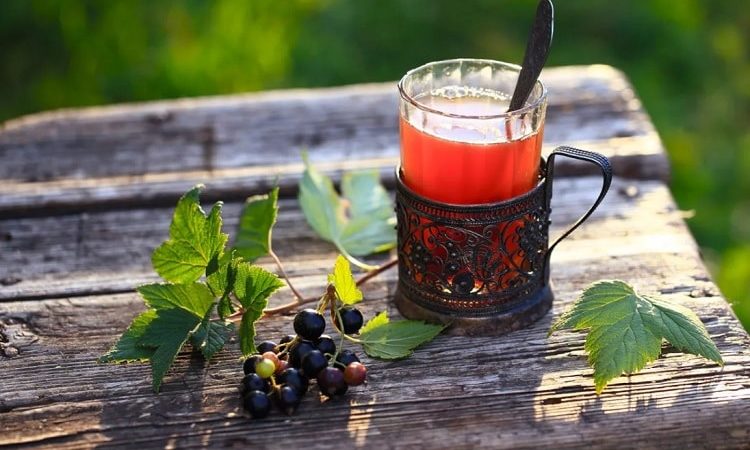
Composition of the drink
100 g of product contains:
- 158 mg potassium;
- 327 mg calcium;
- 370 mg magnesium;
- 0.5 mg iron;
- 7.5 mg phosphorus;
- 1.5 mg copper;
- iodine, manganese, molybdenum and zinc.
The green parts of the plant are rich in essential oils and phytoncides. The composition contains phenolic acids, flavonoids and many other useful bioactive compounds.
Benefits and harms

What are the benefits of leaves? black currant in tea:
- strengthen the cardiovascular system;
- stimulate the gastrointestinal tract;
- increase the overall tone of the body;
- reduce blood pressure;
- increase brain activity and prevent atherosclerosis;
- strengthen the nervous system.
To treat eczema and dermatitis, the decoction is used externally.Due to the presence of phytoncides, currant tea has a healing effect for diseases of the upper respiratory tract. The mild diuretic effect of the drink is used to treat pyelonephritis and eliminate edema.
Important! The catechins contained in currant leaves, the strongest antioxidants, protect the body from the effects of free radicals and reduce the risk of developing cancer.
Despite the obvious benefits, excessive consumption of currant leaf tea can cause allergies. It is recommended to exclude the product for those who suffer from high acidity or hemophilia.
Beneficial features
Tea made from currant leaves has many beneficial properties, which is why it is very popular. It is used to prevent acute respiratory infections and treat many diseases.
For men and women
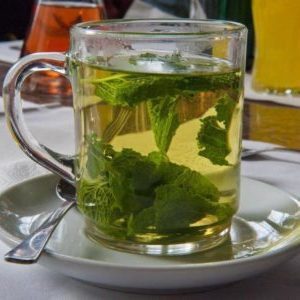
Tea made from currant leaves is widely used to reduce inflammation, treat skin and joint pathologies, and diabetes. The drink reduces the risk of developing Alzheimer's disease. Currant leaves are often used as one of the main ingredients in cosmetics to whiten skin and reduce inflammation. A positive effect on visual acuity and vascular condition was noted.
Preventive properties make tea from currant leaves indispensable in the midst of seasonal colds. It is recommended for pregnant women to use in the autumn-spring period as an absolutely natural remedy. The drink also helps reduce swelling, which is important at different stages of pregnancy.
Important! Blackcurrant, due to its high content of vitamin C, can cause allergies, so you should not abuse this drink during pregnancy.
For children
Tea made from currant leaves is beneficial for both adults and children. The substances in its composition are involved in the formation and regeneration of tissues, help to recover faster after active physical activity, improve memory and concentration. But, since the child’s body is much more susceptible to all kinds of allergens, you should not drink the drink uncontrollably. It is better to limit yourself to small doses several times a week.
Which leaves are suitable for making tea?
To get the maximum benefit from tea, carefully follow all the rules for collecting and preparing currant leaves.
Collection rules
It is difficult to name the exact time for collecting currant leaves, since different varieties bloom and bear fruit at different times. The main sign that it is recommended to focus on is the first flowering of the bushes. It is at this time that currant greens are maximally saturated with useful substances. It is best to collect leaves in the morning, when the dew has already dried, but the greenery has not yet warmed up under the sun. Pay attention to the cleanliness of the leaves: you need to collect only healthy, undamaged parts of the bush. Young shoots from the tops of branches are best suited.
Important! Leaves collected in rainy weather dry poorly and are worse preserved for the winter.
Preparation and processing
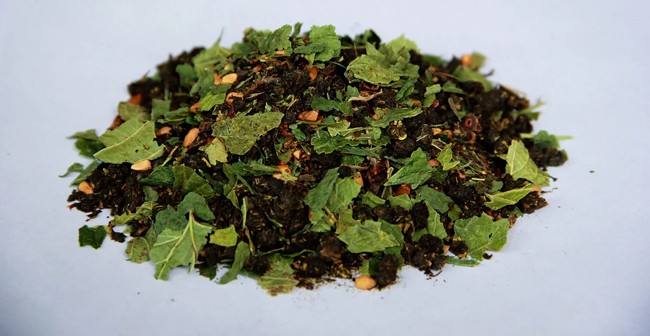
For long-term storage, currant leaves are usually dried, fermented or frozen. Dry greens in a dry room with good air circulation, away from direct sunlight. The raw materials are laid out in one layer and mixed periodically. Under such conditions, it dries in about 4-5 days.
An oven helps speed up the process: it is recommended to keep the collected raw materials at a temperature of +100°C for 15 minutes, and then lower the temperature to +60°C and wait until completely dry.
Important! When choosing a drying method, it is better to give preference to a longer and more traditional one. In the oven, there is a high probability of the leaves drying out, as a result of which the beneficial properties are partially or completely lost.
Dried leaves are stored in a glass jar or natural fabric bag in a dark, dry and cool place. Grind them immediately before brewing tea.
Fermentation
The fermentation process is becoming increasingly popular when harvesting plant leaves for tea. Fermentation of currant greens is carried out in several stages:
- It is necessary to dry it slightly for several hours, focusing on the appearance and condition of the cutting. When the leaves become limp and the stalk becomes flexible and does not break, it is time to move on to the next stage.
- The leaves must be rolled into sausages, crushed between your fingers, or, if there are too many of them, twisted in a meat grinder. The main task of this stage is to achieve the release of juice from the raw material.
- Place the rolled leaves in a bowl or pan and cover with a damp towel to ferment. Place the container in a warm room with a temperature of +25…+27°C. When a pronounced currant aroma appears, it is time to dry.
- Distribute the raw materials evenly on a baking sheet and place in the oven at +100°C for half an hour. After this, check the readiness of the leaves and dry them if necessary.
Despite the fact that the fermentation process, namely rolling the leaves, is very labor-intensive, it is better not to resort to a meat grinder, but to try to preserve their integrity as much as possible.
This is interesting:
How to brew tea from currant leaves correctly
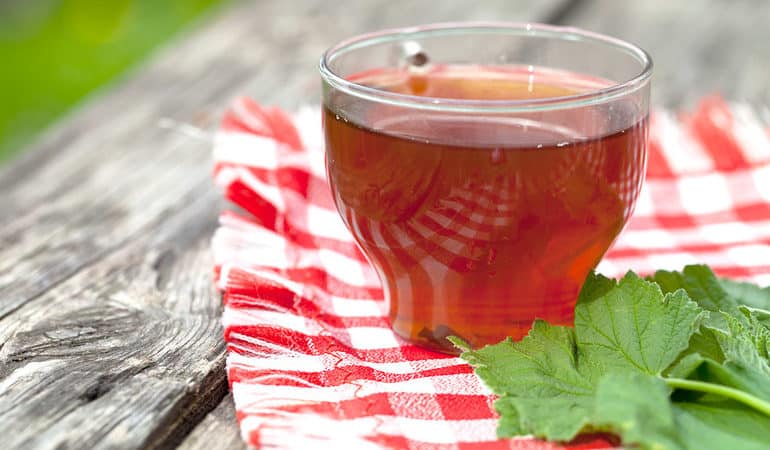
The brewing technology for fresh and dried or fermented currant leaves varies slightly. To maximize the retention of nutrients, follow the following recommendations when brewing tea.
From fresh
To make tea from fresh currant leaves, they are thoroughly washed, cut into small pieces and brewed with boiling water at the rate of 250 ml of water per 2 tsp. leaves. The drink is infused for 15-20 minutes.
From dried/fermented
Dried or fermented currant leaves are pre-crushed. 1 tsp. raw materials are poured with 200 ml of cool water and brought to a boil over low heat. Immediately after boiling, the tea is removed from the heat and filtered.
Recipes for tea with currant leaves
There are many recipes for tea made from blackcurrant leaves, among which everyone will find a drink to their taste.
With berries
To prepare this tea, just take berries and currant leaves in equal proportions and pour boiling water over them. When the drink is infused, it is ready to drink.
With rosehip
Thanks to the combination of beneficial properties of currants and rose hips, this tea is considered a powerful remedy for fighting colds. 50 g of rose hips are mixed with 10 g of currant leaves and pour 1 liter of boiling water.
With mint
This combination has a relaxing and calming effect on the nervous system, helps eliminate toxins and reduce inflammation. Currant and mint tea is an effective remedy for insomnia. To prepare the drink, mix 0.5 tbsp. l. black tea, 2 tbsp. l. currant leaves, 1 tbsp. l. mint. Pour boiling water at the rate of 250 ml of water per 1 tbsp. l. the resulting mixture. Leave for 15 minutes.
With strawberries
Currant leaves are mixed with strawberry leaves or berries in a 2:1 ratio and poured with boiling water. After 15-20 minutes, the drink is ready to drink.
With raspberries
This tea improves immunity, and in case of colds it effectively helps in the fight against cough. You need to take 1 tbsp. l. raspberry and currant leaves and pour 250 ml of boiling water. Leave for 15-20 minutes, then strain. To enhance the anti-cold effect, add honey.
With spices, etc.
Each spice has its own beneficial properties, so you can brew such tea based on your own preferences and the desired effect of consumption. Ginger, cinnamon, cloves, and nutmeg go well with currants.
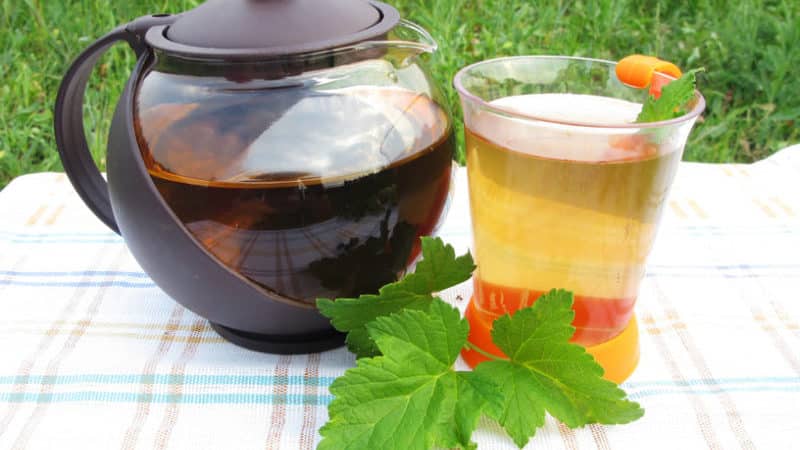
Contraindications
It is not recommended to drink currant drink if:
- gastritis with high acidity or stomach ulcers;
- individual intolerance;
- increased blood clotting and thrombophlebitis.
If you drink this tea regularly, even in the absence of obvious contraindications, you should consult your doctor.
Conclusion
Tea made from currant leaves is one of the most effective and healthy natural drinks. It helps fight colds, improves immunity and is used as part of complex therapy in the treatment of many diseases.However, due to the high content of vitamin C, this tea can cause allergies, so it should be consumed with caution.